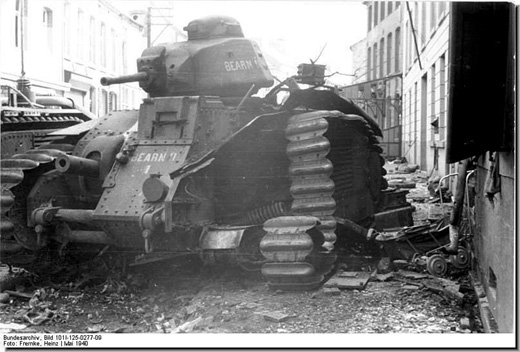Air Operations, Europe
26 LeO-451s with fighter escort bomb Panzers refuelling at Montcornet. 4 are lost. The RAF's Advanced Air Striking Force withdraws from bases south of the Meuse to Troyes area east of Paris.
[China
John Nevin Sayre, self-proclaimed peace ambassador and Christian pacifist, tells Roosevelt that Japan is willing to negotiate and wants to 'retire gracefully' from its costly Chinese war.
[Diplomatic Relations
Churchill writes to Mussolini urging him to avoid a conflict between Britain and Italy. It could well be that the imminent threat of Italian intervention in the war could force the British to give up the Mediterranean route for the safer but longer route around the Cape of Good Hope.
[United States, Politics
Roosevelt asks Congress to authorize plans to modernize the U.S. Army and Navy including the production of 50,000 military planes per year. In all, $1.2 billion is requested to finance this massive operation. Congress applauds him and public opinion is favorable.
[Western Front
The British and French forces which advanced into Belgium only a few days ago, begin to retreat to their former positions behind the line of the Scheldt. The Belgian government moves to Ostend.
French Heavy Tank Char B1 |
 |
Units of Hoth's XV Panzer Corps, with Rommel's 7th Div well to the fore, have penetrated 50 miles into French territory in the direction of Cambrai and to the south Guderian's forces are moving on St Quentin. Again a halt order is issued to the German tank forces because some of the more conservative minds at army headquarters cannot accept that the Panzers can advance so far without exposing their flanks. Towards evening Guderian's armored divs reach a point about 60 miles west of Sedan.
In fact the speed of the advance has itself protected them & thrown the French into confusion. The French Premier, Reynaud, tells Churchill by radio that the battle is lost and the road to Paris already wide open to the enemy. Churchill, accompanied by Sir John Dill, Vice-Chief of the Imperial General Staff, arrives in Paris by air in the early afternoon. He goes to the Quai d'Orsay to meet with Reynaud, Daladier and Gen Gamelin. Perhaps the best indication of the German success is the conversation between Churchill, on a visit to Paris, and Gamelin. Churchill asks where the strategic reserve is and is appalled to receive the answer that there is none, or at least none left. Outside the room where this meeting takes place French government employees are beginning to burn secret files.[MORE]
[